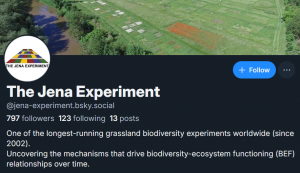New publication from Oelmann et al. in Nature Communications: Above- and belowground biodiversity jointly tighten the P cycle in agricultural grasslands
Experiments showed that biodiversity increases grassland productivity and nutrient exploitation, potentially reducing fertiliser needs. Enhancing biodiversity could improve P-use efficiency of grasslands, which is beneficial given that rock-derived P fertilisers are expected to become scarce in the future. Here, we show in a biodiversity experiment that more diverse plant communities were able to exploit P resources more completely than less diverse ones. In the agricultural grasslands that we studied, management effects either overruled or modified the driving role of plant diversity observed in the biodiversity experiment. Nevertheless, we show that greater above- (plants) and belowground (mycorrhizal fungi) biodiversity contributed to tightening the P cycle in agricultural grasslands, as reduced management intensity and the associated increased biodiversity fostered the exploitation of P resources. Our results demonstrate that promoting a high above- and belowground biodiversity has ecological (biodiversity protection) and economical (fertiliser savings) benefits. Such win-win situations for farmers and biodiversity are crucial to convince farmers of the benefits of biodiversity and thus counteract global biodiversity loss.

Reference:
Oelmann, Y., Lange, M., Leimer, S. et al. Above- and belowground biodiversity jointly tighten the P cycle in agricultural grasslands. Nat Commun12, 4431 (2021). https://doi.org/10.1038/s41467-021-24714-4



